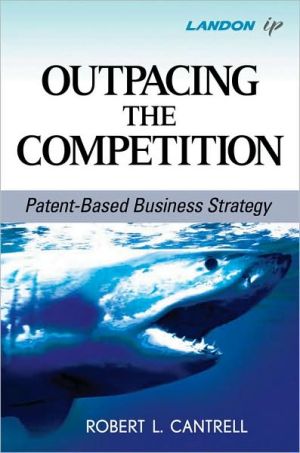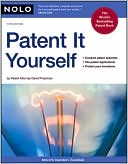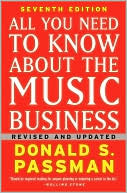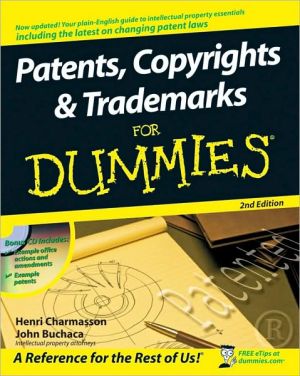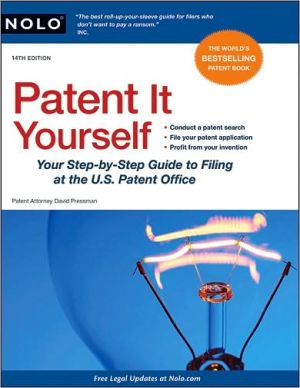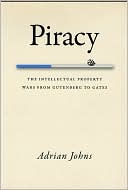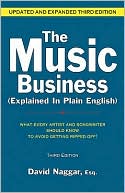Outpacing the Competition: Patent-Based Business Strategy
Praise for Outpacing the Competition Patent-Based Business Strategy\ "Outpacing the Competition provides a useful IP management framework for rapidly evolving and inherently unpredictable R&D environments where companies are partners, customers, and competitors at the same time." Marshall Phelps, Corporate Vice President for IP Policy & Strategy, Microsoft\ "Robert Cantrell's book Outpacing the Competition: Patent-Based Business Strategy should be read by anyone'involved in the...
Search in google:
In the field of patents, there are still innumerable treasures that have not been unearthed; they are hidden in the patent files of a company, or more likely, in the minds of brilliant researchers waiting for the right connection of ideas and support.Taking the mystery out of patent strategy for business management, Outpacing the Competition explores the business dynamics behind creating, acquiring, advancing, and defending patentable assets. Revealing the dynamics central to winning the competition for ideas and relationships through which companies derive successful products, this innovative book puts patentable assets, the core value of technology companies, at the center of a broader business strategy discussion.Combining business strategy with legal and classical strategy, Outpacing the Competition makes it clear how professionals can and should integrate patents into all aspects of business strategy in order for an organization to achieve its full financial potential, with discussion of:Emergent treasures: the creation and acquisition of valuable inventions from bright peopleWays to organize and use non-obvious advantages from the point of view of patent strategyThe ongoing decision cycle of assessment, decision, and actionThe race of decision cycles in determining business tempoPatents as a key driver of business growth for companies The proven strategy models that illustrate how patents workFilled with case studies and real-world anecdotes, this strategic guide equips professionals with tools to cultivate, grow, and guard their patents, and breaks down three key learning points about patent strategy: understanding what patent strategy is, winning the race of decision cycles, and mastering the interplay of interaction and isolation that occurs between companies through patent transactions and enforcement.Patents provide a brief window of opportunity for companies to enforce the exclusivity of their inventions before competitors are able to imitate their ideas. As the most quantifiable of intellectual property assets, patents are the cornerstone of a new type of business strategy that, while practiced, has not been adequately described. Until now.Required reading for business professionals and attorneys, Outpacing the Competition delivers much-needed guidance in developing business strategy that leverages the competitive advantages afforded by patents.
Preface. Orientation. The Grant. Jurisdictions and Costs. Uncertainties. Patent Claims. 18 Months of Secrecy. Requirements to Obtain Patents. Conclusion. Chapter I. Introduction. Strategy Defined. Results. Reasons for Unpredicted Results. Patent Strategy Defined. Value Capture. The Nature of a Strategic Solution. Opposites. Strategic Inaction. Strategy and Change. The Perfect Strategy. The “Good Enough” Strategy. Strategic Risk. Competitive Risk. Chapter II. Decision Cycle. The Question of Cost. B. Invention Review List. Four Rules of Patent Strategy. The Definition of a Decision Cycle. Chapter III. Assess. Defining the Problem. Problem Resolution. Synthesis. Identifying the Opposition. Why Opposition Exists. What Do We Do That Is “Evil”? An Illustration of “Evilness”. “Evilness” Exercise. Why We Act. What We Want. Independent Action. Cooperate or Compete. Evaluating Resources for Cooperate or Compete Decisions. Valuation and Return on Investment. Application of the Patent Resource. Centers of Excellence. Federal Express as a Centers of Excellence Model. Parallel Lines of Competition. All Aspects of Power. Standing on a Whale, Fishing for Minnows. Dominant and Contested Positions. Sanctuary and the Dominant Position. Chapter Summary. Chapter IV. Decide. Defining the Goal. Definition of 'B'. Strategic Versus Technical Solutions. Fundamental Competitive Strategy. Fundamental Competitive Strategy, the Objective, and the Desired Result 'B'. How to Be Proficient at Decision-Making. Overwhelming Advantage. Surprise. Asymmetry. Sanctuary. Leveraging Conditions. Developing the Situation. Four Key Effects: Eliminate, Isolate, Interact, Negate. Competitive Equilibrium and Disequilibrium. Equilibrium. Disequilibrium. A Sample Cause and Effect Sequence. Leveraging the Three Centers of Excellence when Crafting a Strategy. Where We Cooperate and Compete. Innovation. Four Innovation Approaches (Solution Quadrants). Solution Quadrants Illustration. Skating Where the Puck Will Be. Henry Ford. Altshuller's Laws of Technical Evolution. Altshuller and Ideality. The Optimal. Profiting From the Trend Toward the Ideal and the Optimal. From Inventions to Solutions and the Technology Lifecycle. Advancement. The Sales Advantage. Saleable Benefits. Advantages. A Degree of Separation. Security. The Primary Utility of a Patent. The Ultimate Security Advantage. The Ideal Patent. A Counterintuitive Result. Links Within Claims. Links to Other Patents. Links to Other Resources. Parallel Lines of Competition and Security. A Final Word on Asymmetry for Planning. Reciprocal Response. Patent Quality. Drafting a Strong Patent. Position Survivability. The Dominant Patent Strategy. High Tech Dominant Strategy: Stockpile. Rule 1: Use patents to isolate. Rule 2: Threaten to use patents to isolate. Rule 3: Use patents to interact. Rule 4: Leverage the possibility of interaction. Pharmaceutical Dominant Strategy: Seek the Blockbuster. Rule 1: Use patents to isolate. Rule 2. Threaten to use patents to isolate. Rule 3: Use patents to interact. Rule 4: Leverage the possibility of interaction. High Tech Versus Pharmaceutical. Final Word on Decision. Section Summary. Chapter V. Act. Acting on the Goal. Acting Competitively. Mentally Prepare to Adjust. Categorize and Track Resources. Four Operational Tenets. Four Operational Tenets Defined. Concentration of Effort. Economy of Resources. Freedom of Action. Safety. Summary on Operational Tenets. Multi-Dimensional Considerations. Balance. Multi-Dimensional Considerations: Additional Notes. Freedom of Action Enhancements. How to Be Proficient at Operations. A Case of Free Value. Account for Change. Tempo. Decision Cycle and Tempo. Col. John Boyd. Factors of Importance re: Tempo. Levels of Adaptation. The Luck Factor. Qualifying the Result. Summary on Act. Chapter VI. Connecting The Loop. The Invention Review List. Prior Art Search. Invention Elicitation. The Invention Audit. Chapter VII. Two Imperatives. Imperative 1: CEO Involvement. The CEO and the Patent Line of Competition. Bill Gates and Patents. Imperative 2: Master the Fundamentals. AWAKE Cycle™ From Fundamentals to Exceptional Strategy. Chapter VIII. High-Tempo Patent Strategy. Set Common Viewpoints. Measure the Control of Technical Space. Advanced Creativity Techniques. Psychological Protections. Accelerated Invention (TRIZ Example). Conduct Invention/Patent Infiltration. Necessary Adjustments. High-Tempo Patent Strategy Advantages. Chapter IX. Conclusion. Appendix. IP Strategy Boarding and Scenario Play. Endnotes. Orientation. I. Introduction. II. Decision Cycle. III: Assess. IV. Decide. V. Act. VII. Two Imperatives. VIII. High-Tempo Patent Strategy. IX. Conclusion. Appendix 1. IP Strategy Boarding and Scenario Play.
